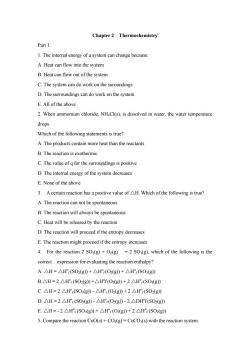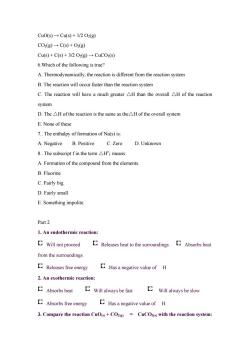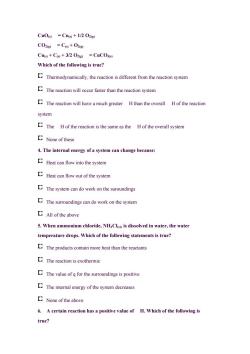北京化工大学:《无机化学》课程电子教案(试卷习题)第二章自我练习题及答案

Chapter2 Thermochemistry Part 1 1.The internal energy ofa system can change because A.Heat can flow into the system B.Heat can flow out of the system C.The system can do work on the suroundings D.The surroundings can do work on the system E.All of the above 2.When ammonium chloride,NHCl(s).is dissolved in water,the water temperature drops. Which of the following statements is true? A.The products contain more heat than the reactants B.The reaction is exothermic C.The value ofq for the surroundings is positive D.The internal energy of the system decreases E.None of the above 3.Acertain reaction has a positive value of H.Which of the following is true? A.The reaction can not be spontaneous B.The reaction will always be spontaneous C.Heat will be released by the reaction D.The reaction will proceed if the entropy decreases E.The reaction might proceed if the entropy increases 4.For the reaction 2 SOx(g)+O(g)=2 SO3(g).which of the following is the correct expression for evaluating the reaction enthalpy? A.△H=△HF:(SO(g)+△H(O(g)+△H:(S0(g) B.△H=2△H°(SO2(g)+△Hf(O2(g)+2△H(SO(g》 C.△H=2△H(S0(g)-△H(O2(g》+2△HF(S02(g) D.△H=2△H:(SO(g)-△H(O2(g)-2△DHf(S02(g) E.△H=.2△H:(S0(g》+△H:(O2(g)+2△H:(S02(g) 5.Compare the reaction CuO(s)+CO2(g)=CuCO3(s)with the reaction system:
Chapter 2 Thermochemistry Part 1 1. The internal energy of a system can change because: A. Heat can flow into the system B. Heat can flow out of the system C. The system can do work on the suroundings D. The surroundings can do work on the system E. All of the above 2. When ammonium chloride, NH4Cl(s), is dissolved in water, the water temperature drops. Which of the following statements is true? A. The products contain more heat than the reactants B. The reaction is exothermic C. The value of q for the surroundings is positive D. The internal energy of the system decreases E. None of the above 3. A certain reaction has a positive value of △H. Which of the following is true? A. The reaction can not be spontaneous B. The reaction will always be spontaneous C. Heat will be released by the reaction D. The reaction will proceed if the entropy decreases E. The reaction might proceed if the entropy increases 4. For the reaction 2 SO2(g) + O2(g) = 2 SO3(g), which of the following is the correct expression for evaluating the reaction enthalpy? A. △H = △Ho f (SO2(g)) + △Ho f (O2(g)) + △Ho f (SO3(g)) B.△H = 2 △Ho f (SO2(g)) +△Ho f(O2(g)) + 2 △Ho f (SO3(g)) C. △H = 2 △Ho f (SO3(g)) - △Ho f (O2(g)) + 2 △Ho f (SO2(g)) D. △H = 2 △Ho f (SO3(g)) - △Ho f (O2(g)) - 2 △DHo f(SO2(g)) E. △H = - 2 △Ho f (SO3(g)) + △Ho f (O2(g)) + 2 △Ho f (SO2(g)) 5. Compare the reaction CuO(s) + CO2(g) = CuCO3(s) with the reaction system:

CuO(s)-Cu(s)+1/2 O2(g) C02(g)→C(s)+02(g) Cu(s)+C(s)+3/2O2(g)-CuCO3(s) 6.Which of the following is true? A.Thermodynamically,the reaction is different from the reaction system B.The reaction will occur faster than the reaction system C.The reaction will have a much greater H than the overall H of the reaction system D.The AH of the reaction is the same as theH of the overall system E.None of these 7..The enthalpy of formation of Na(s)is: A.Negative B.Positive C.Zero D.Unknown 8..The subscript f in the term AHr means: A.Formation of the compound from the elements. B.Fluorine C.Fairly big D.Fairly small E.Something impolite Part2 1.An endothermic reaction: Will not proceed Releases heat to the surroundings Absorbs heat from the surroundings Releases free energy Has a negative value of H 2.An exothermic reaction: CAbsorbs heat Will always be fast Will always be slow Absorbs free energy Has a negative value of H 3.Compare the reaction CuO+COz)=CuCO3)with the reaction system:
CuO(s) → Cu(s) + 1/2 O2(g) CO2(g) → C(s) + O2(g) Cu(s) + C(s) + 3/2 O2(g) → CuCO3(s) 6.Which of the following is true? A. Thermodynamically, the reaction is different from the reaction system B. The reaction will occur faster than the reaction system C. The reaction will have a much greater △H than the overall △H of the reaction system D. The △H of the reaction is the same as the△H of the overall system E. None of these 7.. The enthalpy of formation of Na(s) is: A. Negative B. Positive C. Zero D. Unknown 8.. The subscript f in the term △Ho f means: A. Formation of the compound from the elements. B. Fluorine C. Fairly big D. Fairly small E. Something impolite. Part 2 1. An endothermic reaction: Will not proceed Releases heat to the surroundings Absorbs heat from the surroundings Releases free energy Has a negative value of H 2. An exothermic reaction: Absorbs heat Will always be fast Will always be slow Absorbs free energy Has a negative value of H 3. Compare the reaction CuO(s) + CO2(g) = CuCO3(s) with the reaction system:

CuO()Cu(s)+1/2 02(g) CO2(g)=C()+02g) Cus)+C()+3/2 02(g)=CuCO3(s) Which of the following is true? Thermodynamically,the reaction isdiffern from the reaction system Thereaction will cr faster than the reaction system The reaction will have a much greater Hthan the overall Hof the reaction system The Hofthe reaction is the same as the Hof the overall system None of these 4.The internal energy of a system can change because: Heat can flow into the system Heat can flow out of the system The system can do work on the suroundings The surounding can do work on the system All of the above 5.When ammonium chloride,NHaCls)is dissolved in water,the water temperature drops.Which of the following statements is true? heat than the reactants The reaction is exothermie The value of for the surroundings is positive The internal energy of the system decreases None of the above 6.A certain reaction has a positive value of H.Which of the following is true?
CuO(s) = Cu(s) + 1/2 O2(g) CO2(g) = C(s) + O2(g) Cu(s) + C(s) + 3/2 O2(g) = CuCO3(s) Which of the following is true? Thermodynamically, the reaction is different from the reaction system The reaction will occur faster than the reaction system The reaction will have a much greater H than the overall H of the reaction system The H of the reaction is the same as the H of the overall system None of these 4. The internal energy of a system can change because: Heat can flow into the system Heat can flow out of the system The system can do work on the suroundings The surroundings can do work on the system All of the above 5. When ammonium chloride, NH4Cl(s), is dissolved in water, the water temperature drops. Which of the following statements is true? The products contain more heat than the reactants The reaction is exothermic The value of q for the surroundings is positive The internal energy of the system decreases None of the above 6. A certain reaction has a positive value of H. Which of the following is true?

The reaction can not be spontaneous The reaction will always be spontaneous Heat will be released by the reaction The reaction will prced if th entropy decreases The reaction might proceed if the entropy increases 7.For the reaction 2SO+2SO which of the following is the correct expression for evaluating the reaction enthalpy? H=Hr(SOz)+H':(Oz)+H:(SOxg) CH=2H(S02)+H:(O2g)+2P(S03e H=2 Hr(SOxp)-H:(O2m)+2 H (SOx) CH=2Hr(S03e)-HP:(O2e)-2DF:(S02e) C H=.2 H(SO)+Hr(Ox)+2 H':(SOxp) 8.The enthalpy of formation of Na is: C Negative Positive C Unknown 9.The superscript in the term Hr means: The reaction is carried out at zero degress Celcius The enthalpy fisr. None of the above 10.The subscriptrin the term Hr means: Formation of the compound from the elements CFluorine
The reaction can not be spontaneous The reaction will always be spontaneous Heat will be released by the reaction The reaction will proceed if the entropy decreases The reaction might proceed if the entropy increases 7. For the reaction 2 SO2(g) + O2(g) 2 SO 3(g), which of the following is the correct expression for evaluating the reaction enthalpy? H = Ho f (SO2(g)) + Ho f (O2(g)) + Ho f (SO3(g)) H = 2 Ho f (SO2(g)) + Ho f (O2(g)) + 2 Ho f (SO3(g)) H = 2 Ho f (SO3(g)) - Ho f (O2(g)) + 2 Ho f (SO2(g)) H = 2 Ho f (SO3(g)) - Ho f (O2(g)) - 2 DHo f (SO2(g)) H = - 2 Ho f (SO3(g)) + Ho f (O2(g)) + 2 Ho f (SO2(g)) 8. The enthalpy of formation of Na(s) is: Negative Positive Zero Unknown 9. The superscript o in the term Ho f means: The reaction is carried out at zero degress Celcius. The reaction is carried out at zero pressure. The enthalpy of reaction is zero. The reaction is carried out at standard conditions. None of the above 10. The subscript f in the term Ho f means: Formation of the compound from the elements. Fluorine

口Fairly big C Fairly small Something impolite Question 1. Endothermic reactions absorb heat, Question 2. Exothermic reactions have negative values of DH Question 3. The reactions in the system sum to the given reaction.The enthalpies of both are therefore equal,according to Hess'law. Question 4 All of the answers are correct.The change in internal energy is equal to the change in heat plus the work done. Question 6. An endothermic reaction will be spontaneous only if the entropy change is sufficiently positive. Question 7. DH=2 DHof(SO3(g))-DHof(O2(g))-2 DHof(SO2(g)) Question 8. The enthalpy of formation of any element is zero
Fairly big Fairly small Something impolite Question 1. Endothermic reactions absorb heat, Question 2. Exothermic reactions have negative values of DH. Question 3. The reactions in the system sum to the given reaction. The enthalpies of both are therefore equal, according to Hess' law. Question 4. All of the answers are correct. The change in internal energy is equal to the change in heat plus the work done. Question 6. An endothermic reaction will be spontaneous only if the entropy change is sufficiently positive. Question 7. DH = 2 DHof (SO3(g)) - DHof (O2(g)) - 2 DHof (SO2(g)) Question 8. The enthalpy of formation of any element is zero

Question9. The superscript means that the reaction is carried out under standard conditions
Question 9. The superscript means that the reaction is carried out under standard conditions
按次数下载不扣除下载券;
注册用户24小时内重复下载只扣除一次;
顺序:VIP每日次数-->可用次数-->下载券;
- 北京化工大学:《无机化学》课程电子教案(试卷习题)第三章自我练习题及答案.pdf
- 北京化工大学:《无机化学》课程电子教案(试卷习题)作业习题(中英文)安排及部分答案.pdf
- 北京化工大学:《无机化学》课程电子教案(试卷习题)自测题及答案-9.pdf
- 北京化工大学:《无机化学》课程电子教案(试卷习题)自测题及答案-8.pdf
- 北京化工大学:《无机化学》课程电子教案(试卷习题)自测题及答案-10.pdf
- 北京化工大学:《无机化学》课程电子教案(试卷习题)自测题及答案-7.pdf
- 北京化工大学:《无机化学》课程电子教案(试卷习题)自测题及答案-6.pdf
- 北京化工大学:《无机化学》课程电子教案(试卷习题)自测题及答案-5.pdf
- 北京化工大学:《无机化学》课程电子教案(试卷习题)自测题及答案-4.pdf
- 北京化工大学:《无机化学》课程电子教案(试卷习题)自测题及答案-3.pdf
- 北京化工大学:《无机化学》课程电子教案(试卷习题)自测题及答案-2.pdf
- 北京化工大学:《无机化学》课程电子教案(试卷习题)自测题及答案-1.pdf
- 北京化工大学:《无机化学》课程电子教案(试卷习题)无机化学(双语)期末考试模拟试卷-B-试题.pdf
- 北京化工大学:《无机化学》课程电子教案(试卷习题)无机化学(双语)期末考试模拟试卷-B-答案.pdf
- 北京化工大学:《无机化学》课程电子教案(试卷习题)无机化学(双语)期末考试模拟试卷-A-答案.pdf
- 北京化工大学:《无机化学》课程电子教案(试卷习题)无机化学(双语)期中考试模拟试卷-B-试题.pdf
- 北京化工大学:《无机化学》课程电子教案(试卷习题)无机化学(双语)期中考试模拟试卷-B-答案.pdf
- 北京化工大学:《无机化学》课程电子教案(试卷习题)无机化学(双语)期末考试模拟试卷-A-试题.pdf
- 北京化工大学:《无机化学》课程电子教案(试卷习题)无机化学(双语)期中考试试卷-A-试题.pdf
- 北京化工大学:《无机化学》课程电子教案(试卷习题)无机化学(双语)期中考试试卷-A-答案.pdf
- 北京化工大学:《无机化学》课程电子教案(试卷习题)第五章自我练习题及答案.pdf
- 北京化工大学:《无机化学》课程电子教案(试卷习题)第六章自我练习题及答案.pdf
- 北京化工大学:《无机化学》课程电子教案(试卷习题)第四章自我练习题及答案.pdf
- 北京化工大学:《无机化学》课程电子教案(试卷习题)第七章自我练习题及答案.pdf
- 北京化工大学:《无机化学》课程电子教案(试卷习题)第九章自我练习题及答案.pdf
- 北京化工大学:《无机化学》课程电子教案(试卷习题)第八章自我练习题及答案.pdf
- 北京化工大学:《无机化学》课程电子教案(试卷习题)第十一章自我练习题及答案.pdf
- 北京化工大学:《无机化学》课程电子教案(试卷习题)第十章自我练习题及答案.pdf
- 北京化工大学:《无机化学》课程电子教案(试卷习题)第十三章自我练习题及答案.pdf
- 北京化工大学:《无机化学》课程电子教案(试卷习题)第十二章自我练习题及答案.pdf
- 北京化工大学:《无机化学》课程电子教案(试卷习题)第十四章自我练习题及答案.pdf
- 北京化工大学:《无机化学》课程电子教案(试卷习题)第十三-十四章综合自我练习题及答案.pdf
- 北京化工大学:《无机化学》课程电子教案(试卷习题)第十五章自我练习题及答案.pdf
- 北京化工大学:《无机化学》课程电子教案(试卷习题)第十七章自我练习题及答案.pdf
- 北京化工大学:《无机化学》课程电子教案(试卷习题)第十六章自我练习题及答案.pdf
- 北京化工大学:《无机化学》课程电子教案(试卷习题)第十六-十七综合自我练习题及答案.pdf
- 北京化工大学:《无机化学》课程电子教案(教学课件,2011)Chapter 01 前言 Preface(负责人:周云山).pdf
- 北京化工大学:《无机化学》课程电子教案(教学课件,2011)Chapter 02 Thermochemistry.pdf
- 北京化工大学:《无机化学》课程电子教案(教学课件,2011)Chapter 03 Chemical kinetics.pdf
- 北京化工大学:《无机化学》课程电子教案(教学课件,2011)Chapter 05 Acid-Base Equilibrium.pdf
